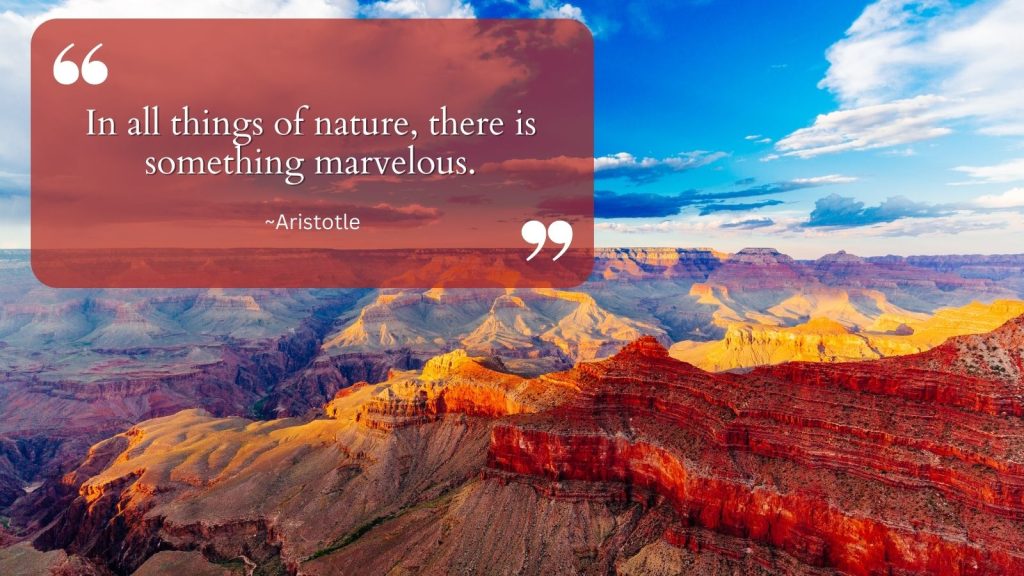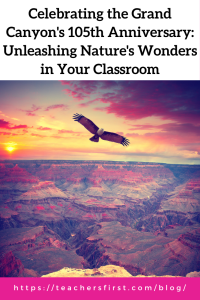
Did you know that on January 11th, 1919, the Grand Canyon achieved a historic milestone, transforming from a National Monument to a National Park? This pivotal transition showed a commitment to preserving and celebrating the canyon’s breathtaking beauty for generations to come.
Another significance of this transition is that it embodies a higher level of preservation than a national monument. It secures more federal funding for conservation and future projects.
As we honor this anniversary, it’s a reminder that you, too, can place a higher value on preserving and exploring natural wonders. Think of it as an invitation to educators, parents, and caretakers to forge connections between their students and this awe-inspiring natural treasure. This blog will help you and your classroom community connect with nature meaningfully and relevantly.
As dedicated educators, you aspire to immerse your students in the wonders of nature but often come across barriers. Field trips to national parks or outdoor excursions might not be doable due to financial or logistical constraints. Yet, within our classrooms there exist resources that allow us to nurture profound connections with nature without ever having to leave.
- Virtual Tours of National Parks – Explore the majestic landscapes and diverse ecosystems of national parks through immersive virtual tours. These digital journeys offer a window into the beauty and wonder of these natural spaces, allowing students to experience the grandeur of places they might not physically visit.
- National Park Service Teaching Resources – Tap into an array of teaching resources curated by the National Park Service. These materials are designed to integrate nature-based education into lesson plans seamlessly.
- WWF Teaching Toolkits – The World Wildlife Fund provides engaging teaching toolkits, offering a wealth of materials to foster a deeper connection with nature. These resources inspire curiosity, encourage exploration, and facilitate a greater understanding of the natural world without straining limited budgets.
Another way to nurture students’ connection with nature is by offering guidance and resources to their parents and caregivers. This article, 11 Tips for Parents to Connect Kids to the Outdoors, provides practical tips that empower caregivers and parents to ignite a love for nature in their children. One standout resource from this article is a video demonstrating creating a sound map. Shared by Colorado PLT Coordinator Danielle Ardrey, this video provides step-by-step instructions for children to craft their own sound map in a backyard setting, urging them to listen, observe, and map the captivating sounds of their environment.
It’s also important to recognize that not all communities feel included in exploring outdoor environments. That’s why there are initiatives and organizations striving to ensure that outdoor spaces are accessible and welcoming for everyone. This article is a resource to share with your classroom community, emphasizing the efforts and providing resources supporting more inclusive outdoor spaces.
Lastly, I want to share some additional articles from our TeachersFirst Blog that can further you and your students connection with nature:
- Staying Close to Home for Great Outdoors Month – This post encourages celebrating Great Outdoors Month by suggesting outdoor activities for elementary, middle, and high school students, such as gardening, outdoor games, and citizen science projects, while also promoting sharing activities with family and friends through various platforms.
- A Guide to Getting Kids Outside – This post emphasizes the importance of getting children outdoors during the summer, highlighting the numerous physical, mental, and social benefits, such as building confidence, promoting creativity, and reducing stress. It suggests using technology to enhance outdoor experiences, making outdoor activities a family affair and provides ideas for low-cost or no-cost outdoor games.
- Incredible Resources from the National Park Service to Use in Any Classroom – This post highlights the wealth of educational resources provided by the National Park Service website, offering various ideas for incorporating them into classroom lessons. It suggests exploring parks by state, utilizing the park service search in reading classes, and engaging students with activities such as planning a visit to a national park.
I hope you explore these articles for further insights and ideas on celebrating and fostering a deep appreciation for the great outdoors. Feel free to share your thoughts, experiences, or additional resources in the comments below. Let’s continue to inspire each other on this journey of nature appreciation!


